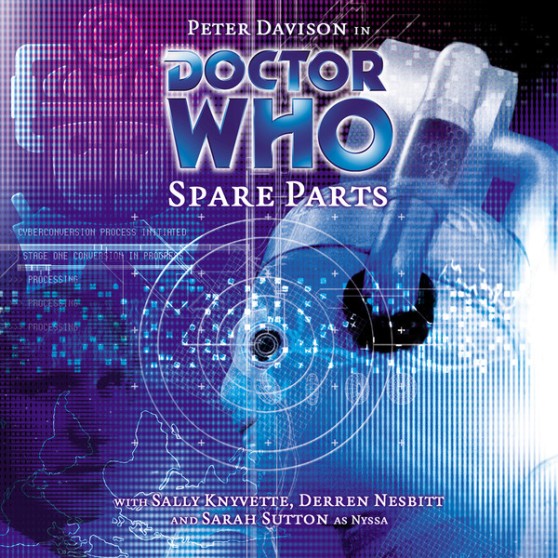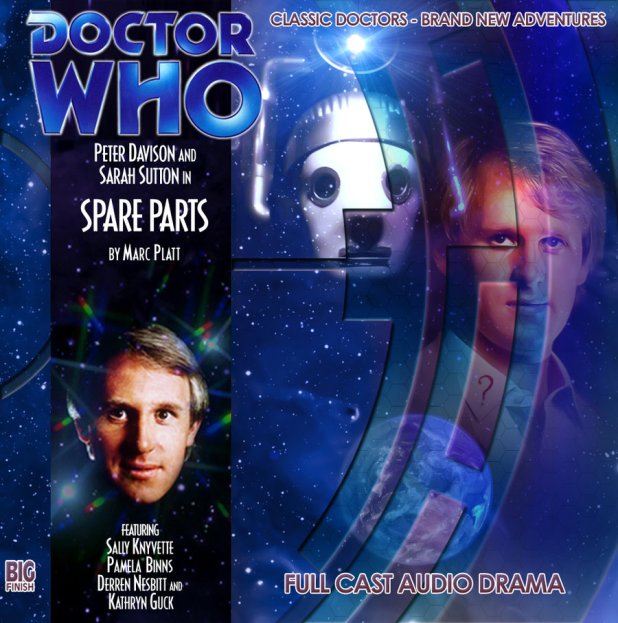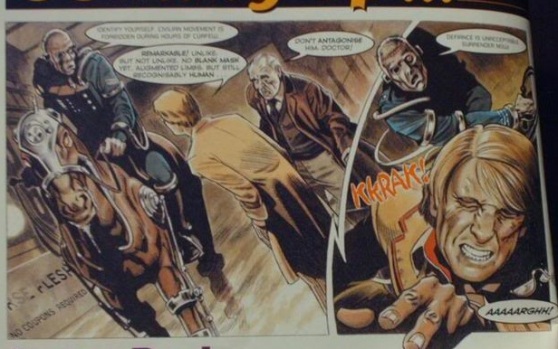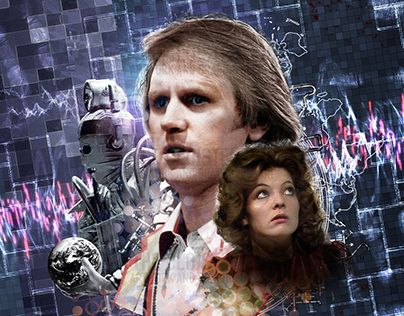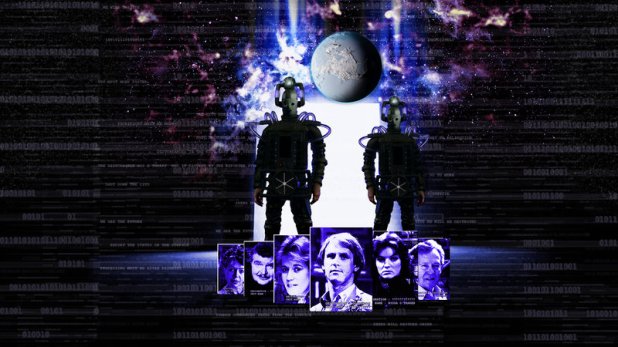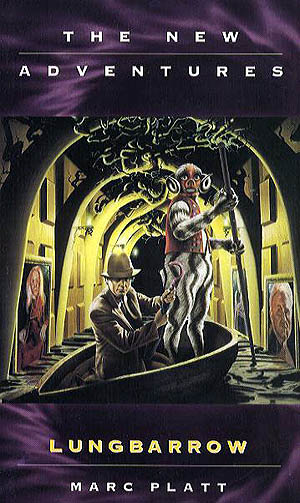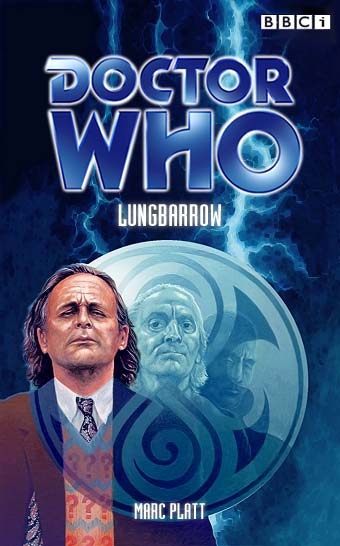We’re back, with another Big Finish Doctor Who audio drama review! Today, we’re taking a detour from our regular schedule, and listening to Spare Parts, number thirty-four in the main range of audios. Here, we’ll get a look at the origin of one of Doctor Who’s most iconic villains: the Cybermen! Let’s get started!
Spoilers ahead for anyone who has not listened to this audio drama!
Somewhere, an explorer named Donald Philpott steps onto a planet’s surface, the first in many years to do so. It’s a moment of victory—and suddenly turns to disaster.
The Fifth Doctor and Nyssa land the TARDIS in a curious place. It appears to be London or a similar city, circa 1950s…but London never had a roof of stone over its collective heads. Further, the TARDIS’s systems indicate they are in deep space, near a dangerous formation called the Cherrybowl Nebula. Space is unstable and deadly in the area, but that’s not the strangest part: This planet doesn’t seem tied to any star.
The Doctor, showing uncharacteristic anxiety, wants to leave right away. Nyssa, however, wants to explore, and so he reluctantly gives her half an hour, and goes out on his own as well. Nyssa meets a woman named Yvonne Hartley, along with her father; Mr. Hartley is injured, and Nyssa believes him to be dead—no pulse can be found—but he proves to be mostly unharmed. They quickly take her home with them, as a curfew has arrived. Meanwhile, the Doctor meets one Thomas Dodd, and finds that he has an unusual business: he deals in human organs and limbs. Transplants are common here, in both natural and artificial—or cybernetic—parts. Dodd confirms what the Doctor has feared: this planet, a rogue world wandering the stars, is called Mondas—a name the Doctor knows well, for it is the homeworld of the Cybermen. They are interrupted by a cyber-augmented policeman on a similarly augmented horse; the Doctor creates a distraction, allowing them to escape.
Nyssa has her own brush with the authorities in the form of Sisterman Constant, a sort of public nurse, who comes to the Hartleys’ apartment. Nyssa has no identity papers, making Constant suspicious; Constant leaves, but calls in about Nyssa’s presence. She also reports Yvonne as a possible conscript, or “call-up”, for the work crews in the city. Nyssa meets Frank, Yvonne’s younger brother, and also learns that cybernetic animals are as common as cybernetic people; the replacement of parts with cybernetic substitutes is very common, and many people are in ill enough health to require such replacement. She also witnesses a disturbance in the street, and sees that a neighbor is carried off by police.
The Doctor also sees the disturbance, and realizes that something illicit is happening during the night. He and Dodd make their way to an abandoned church tower to observe, and find that bodies are being exhumed and taken from a graveyard by the augmented police. They are caught by a policeman, who dies in the struggle; they flee, but the Doctor causes the church bell to ring, rousing the people in the neighborhood to see what is going on. He resolves to that if he can’t change this future, he will help the people try to change it themselves.
Mr. Hartley reveals his own enhancement: a chest unit that keeps his heart beating. It needs repairs, which Nyssa provides. Nyssa is forced to flee when the police—summoned by Constant—arrive; Yvonne gives her a gift: her old pet, an augmented creature called a Cybermat. She meets the Doctor at the TARDIS, but refuses to leave; she wants to change the Cybermen’s history, though the Doctor says it can’t be done. Unknown to them, the Committee—the cybernetic gestalt which controls the city—has already become aware of them, and ordered their elimination.
Nyssa argues with the Doctor, and brings up the death of Adric. They are diverted, however, by the presence of the Cybermat; it chews into the TARDIS console, seeking the power source, until it fries itself—but the damage is done. The Doctor leaves Nyssa to begin repairs, and goes out, and sees that the police have stopped the bells and dispersed the crowd.
Constant has returned to the Committee’s palace. There, a Doctorman—the chief researcher under the committee—named Christine Allan is drinking away her frustrations. She has had problems with augmenting—converting, really; she calls it processing—the work crews, and the Committee is demanding a pace that prevents revision of the process. Hearing Constant’s story, she sends Cybermats to observe the visitors. The Committee then summons her, and demands more processing subjects.
In the morning, Frank goes in search of Nyssa, and finds the Doctor near the TARDIS. The Doctor sends him inside to speak with Nyssa, and then leaves to find Dodd. Inside, Frank gets over his astonishment at the TARDIS, and helps Nyssa with the repairs; he explains that Cybermats are attracted to power sources. It proves true; a horde of them are observed trying to break into the TARDIS—and Frank left the outer door open…Nyssa routes the power into the shell of the TARDIS to fry them all. Afterward, Nyssa and Frank return to his apartment, where they discover that the Committee has announced its plan to convert everyone.
Constant meets with Allan, and learns, to her horror, that the Committee will soon process everyone, turning them all into the latest iteration: the Cybermen. Allan, thoroughly drunk, goes out to find the Doctor and interrogate him, having seen him via her Cybermats. Along the way, she passes Yvonne’s work group, which is about to be processed. Meanwhile, the Committee learns that Mondas is approaching the nebula—and its catastrophic instability—sooner than anticipated. They call the leader of the work crews, the fully-converted Zheng, back to the city to deal with the problems going on.
The Doctor asks Dodd to help him get to the Committee; but Dodd traps him in a freezer instead, reasoning that he is healthy and will make a good source of organs. He is rescued by Allan, who takes him along with Dodd for use in experimentation. They are interrupted by a blackout, and the roof of the cavern begins to cave in.
Yvonne’s group is not fully processed when the blackout happens, and she has wandered off. The rest are confused and demanding to be told their purpose; but they are already aware that they must protect the Committee. Allan persuades them that she must restart the palace generators, and she is accompanied there. The Doctor and Dodd infiltrate the palace, and find that enough Cyberman frames have been constructed to convert the entire population. Dodd flees, later to be captured and converted. The Doctor rescues Allan from her escort, but is nearly killed when gold leaf—a common weakness of later Cybermen—doesn’t work on this one; Allan activates a kill switch on the Cyberman to stop it, and goes with the Doctor to the generators.
Outside, it’s getting darker and colder, as the city is exposed to the surface by the broken roof. A Cyberman breaks into the Hartleys’ apartment; they are horrified to find it is Yvonne. She doesn’t remember them; but when the Doctor gets the power back on, she suffers a seizure from too many signals, and dies.
The Doctor is forced to manually activate the generators. Zheng arrives, and sends Constant for processing. He reveals that the Cybermen were created for only one purpose: to activate and control a large propulsion system on the surface, which will save Mondas from the nebula by rerouting the planet’s trajectory. The final breaker on the generators is jammed; Zheng activates the power early, electrocuting the Doctor and seemingly killing him. The Committee decides to put Zheng in charge instead of Allan. However, the Doctor is still alive, and recovering; Allan marvels at this, and persuades Zheng that she must examine him, as he may represent new possibilities for the Cybermen. Initial scans show that he has a discrete lobe in his brain which can handle bodily functions unaided, allowing the rest of the brain to devote to cognitive capabilities; this pattern can be useful in the next generation of Cybermen, and may solve the problems Allan has been facing. To his horror, the Doctor realizes that the Cybermen of the future will owe their existence to him.
The Committee faces a conundrum. If they do not repair the roof, the people will die; but if they divert resources from the propulsion system to effect repairs, the planet may be destroyed. To resolve it, they order that everyone remaining be processed into Cybermen. Nyssa is brought to the palace, only to see Zheng start the full scan on the Doctor. The Committee finds itself divided with regard to the Doctor’s usefulness; realizing that division is their greatest problem, they eliminate their individuality and combine their minds into one, and become the first Cyber-Planner.
When the scanner opens, a new Cyberman is revealed; Nyssa believes it is the Doctor. However, it is Dodd, having been converted according to the new template based on the Doctor. The Doctor is still alive. The Doctor and Nyssa borrow wine from Allan, who is now despondent at the end result of her work, and use it to contaminate the Cyber-Planner’s nutrient feed. Allan goes to warn the Cyber-Planner, and meets Zheng on the way; he says that the propulsion system must be activated right away.
Nyssa, Frank, and Allan are all captured and taken to the processing lines, but the Doctor succeeds in contaminating the Cyber-Planner’s nutrient feed. It becomes irrational, pulling power from the propulsion system to protect itself. The Doctor reconnects with Hartley; together they create an energy pulse that attracts a horde of Cybermats to the Cyber-Planner, disorienting it and allowing Zheng to divert power back to the propulsion system. Mondas is redirected away from the Nebula, and the Cyber-Planner shuts down; Zheng, critically injured, appears to die as well.
In the aftermath, the Doctor and Nyssa help Allan formulate a plan to reverse some aspects of the processing, making the Cybermen potentially more human. It will not prevent their existence, but may alter the course of their history for the better. However, after the TARDIS departs, Allan finds that Zheng has not died as she thought…and processing will continue, against her will, until every Mondan is a Cyberman. Meanwhile, the planet hurtles through space on a new course, one that will take it back to the solar system from which it came, and to a confrontation with the First Doctor…and the planet Earth.
This story was written by Marc Platt, author of the Seventh Doctor serial Ghost Light, and also of the famous (or possibly infamous?) New Adventures novel, Lungbarrow. I’ve opted to review it here, out of order for the main range, because it serves as the inspiration for the Series Two episodes Rise of the Cybermen and The Age of Steel. While it’s often been suggested that the revived television series sometimes steals ideas from Big Finish’s audios, this was a more overt usage: Marc Platt received both credit and payment for the use of his concepts.
The television episodes, which I reviewed yesterday, gave us the origin of the new series version of the Cybermen, via an alternate-universe corporation called Cybus Industries. This story, in contrast, gives us the origin of the original Cybermen in the normal Doctor Who universe, sometimes referred to as N-Space. We’ve known since Season Four’s The Tenth Planet—the final story for the First Doctor—that the Cybermen originated with Earth’s twin planet, known as Mondas; and that Mondas was ejected from its orbit in the distant past and sent careening through the cosmos as a rogue planet, before eventually returning. Mondas is an interesting subject in its own right; it is not just a twin of Earth in the sense of sharing an orbit (though it did indeed share an orbit before its ejection), but indeed, it is identical to Earth, having matching continents and oceans, as can be seen in The Tenth Planet. It is also populated by people who are, for every practical purpose, human; they call themselves such, and are biologically the same as Earth humans. It has never been established how these oddities came to be. In fact, Mondasian (and I use that word for lack of any clear direction; “Mondan” may also be correct) society is parallel to Earth to an incredible degree, to the point that even words and mannerisms are seen to be the same (to a degree that exceeds that of TARDIS translation). However, the Mondans are technically more advanced; the Doctor comments as much here, and says that the cultural level—equivalent to the 1950s—is a result of deliberate repression by the Committee.
Early drafts of the television episodes reflected a dying Earth (though this was abandoned in the final release); accordingly, Mondas is a dying world. The city seen here is alleged to be the last city on the planet, and its population is estimated at about three thousand. The surface is uninhabitable; even Cybermen only have a nineteen percent survival rate on the surface. Still, this is to be expected on a rogue planet; in its own way, Pete’s Earth, on the television series is more of an anomaly. The Doctor in that episode claims that there are no Time Lords in that universe; and yet he and the Time Lords have affected the development of N-Space Earth so much that the alternate version should be radically different, if it exists at all. Fortunately, this audio corrects that a bit: if the Cybermen exist partly because of the Doctor, then his absence in Pete’s universe may have caused them to never exist, which explains why they didn’t conquer Earth in 1980, long before the events of the episode. But we’re getting far afield here.
This audio is stated by Big Finish to occur between Time-Flight and Arc of Infinity; and indeed it must, as with all stories that only include Nyssa. Tegan exited the TARDIS in Time Flight and returned in Arc of Infinity; Nyssa was never alone with the Doctor again, as Turlough joined the crew before Nyssa exited in Terminus. Adric, as the audio mentions, was already dead; the Doctor admits that he never properly stopped to mourn his death.
These Cybermen differ from their later versions in several ways. They do not suffer the weakness to gold, as the Doctor discovers; I can only assume that the modified respiratory system is a later innovation, though it seems like a step backward here. Before the Doctor is scanned, the Cybermen suffer frequent organ failures, miscoordination, and programming errors; his bioscans provide the solution to these problems. Cybermen are seen here in various stages of conversion; it was not a one-time development, and the Doctor sarcastically comments at one point that it began with cosmetic surgeries. Interestingly, Torchwood will later reveal a partially-converted Cyberman, of the Cybus variant, which is at odds with the conversion process we see in The Age of Steel.
In addition to the obvious links to various Cyberman stories (The Tenth Planet, The Tomb of the Cybermen, Revenge of the Cybermen, Earthshock, Attack of the Cybermen, Silver Nemesis), there’s a considerable amount of reference to The Keeper of Traken and Logopolis. Nyssa talks at length about her lost world and family, even elaborating on Trakenite holidays and festivals. She makes an oblique reference to the Master, saying that her father “went away”; in reality, Tremas’s body was stolen by the Master, and maintained until at least *Survival, and possibly all the way to his death in the television movie. In the other direction, future episodes of the revived series will make reference to this story; the Mondasian Cybermen will eventually merge with the Cybus variant, and a Cyber-Planner (though not the same one in any case) will appear in Nightmare in Silver, as well as several audios: The Girl Who Never Was; Legend of the Cybermen; Last of the Cybermen; and the Cyberman range of audios.
Some technical details: This is a long story, clocking in at more than a half hour per part, with a total running time of about two and a quarter hours. Each part has been given an individual title, much like the early seasons of the classic series: “Surfacing”; “Necessary Force”; “Popping the Seals”; and “Shelter”.
This is a haunting story to which to listen; personally, I find it more so than Genesis of the Daleks, to which it might be compared. While the Kaleds and the Mondasian humans are equally victimized, the Kaleds were at the end of a horrific and long-lasting war, which makes them harder to sympathize with. The humans here, however, just want to live; and they are truly deluded about how to go about it. As well, there’s no individual to blame here, unlike the alternate universe’s John Lumic, who can easily be compared to Davros (they even both require a life-support chair). Perhaps it’s simply that the Cybermen have caused so much emotional misery—not least of all, the death of Adric, whom many fans still mourn—or perhaps it’s that they are simply so much like us to begin with; but either way, this story is full of both dread and sorrow at what they become.
Next time: Back to the normal schedule, we’ll be looking at Destiny of the Doctor: Vengeance of the Stones, followed by Main Range #13, The Shadow of the Scourge! See you there.
All audio dramas featured in this series may be purchased from Big Finish Productions; link to this story’s purchase page is below. This and many other selections can also be found on Spotify and Google Play.


